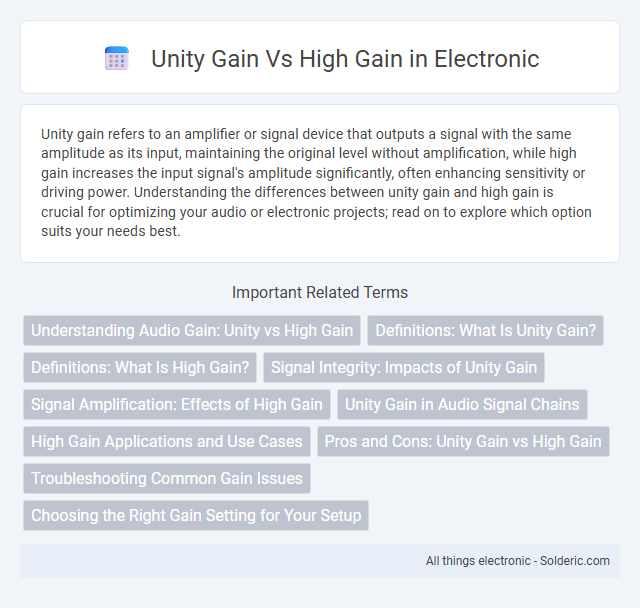Unity gain refers to an amplifier or signal device that outputs a signal with the same amplitude as its input, maintaining the original level without amplification, while high gain increases the input signal's amplitude significantly, often enhancing sensitivity or driving power. Understanding the differences between unity gain and high gain is crucial for optimizing your audio or electronic projects; read on to explore which option suits your needs best.
Comparison Table
| Feature | Unity Gain | High Gain |
|---|---|---|
| Definition | Output signal equals input signal (gain = 1) | Amplifies input signal significantly (gain > 1) |
| Purpose | Signal buffering, impedance matching | Signal amplification, increasing signal strength |
| Signal Strength | Maintains original signal level | Boosts signal amplitude |
| Noise Impact | Minimal noise addition | Potential for increased noise |
| Power Consumption | Lower power usage | Higher power consumption |
| Typical Applications | Voltage followers, buffers | Audio amplifiers, RF amplifiers |
Understanding Audio Gain: Unity vs High Gain
Unity gain in audio systems means the input and output signal levels remain equal, ensuring no amplification or attenuation occurs, preserving sound fidelity. High gain significantly boosts the signal amplitude, which can enhance volume but may introduce noise or distortion if not managed properly. Understanding the impact of these gain settings helps you optimize your audio equipment for clear, balanced sound performance without unwanted artifacts.
Definitions: What Is Unity Gain?
Unity gain refers to an amplifier or circuit configuration where the output signal maintains the exact amplitude as the input signal, resulting in a gain factor of one (1). This means the signal is neither amplified nor attenuated, preserving its original strength and fidelity. Your choice of unity gain is critical in applications that require signal buffering or impedance matching without altering the signal magnitude.
Definitions: What Is High Gain?
High gain refers to the amplification level where the input signal is significantly increased, often used to achieve stronger output or enhanced sensitivity in audio and electronic systems. Unity gain means the output signal is equal in amplitude to the input, providing no amplification but preserving the signal's integrity. Your choice between unity gain and high gain depends on whether you need pure signal fidelity or powerful signal boost.
Signal Integrity: Impacts of Unity Gain
Unity gain amplifiers preserve signal integrity by maintaining the original signal amplitude without amplification, minimizing distortion and noise introduction. This consistent output is crucial in sensitive applications like sensor signal conditioning, where any gain-induced alteration could compromise data accuracy. Your system benefits from improved linearity and reduced total harmonic distortion when employing unity gain configurations over high gain setups.
Signal Amplification: Effects of High Gain
High gain settings in audio systems significantly amplify signal strength, which increases the output volume and sensitivity to input signals. This amplification can introduce more noise and distortion, impacting sound clarity and quality compared to unity gain, where the output level matches the input without added amplification. Proper management of high gain is crucial for balancing loudness with audio fidelity in various sound equipment applications.
Unity Gain in Audio Signal Chains
Unity gain in audio signal chains means the input and output levels are equal, preserving the original signal without amplification or attenuation. High gain, by contrast, increases the signal strength, often adding distortion or color to enhance sound characteristics in guitar amplifiers or effects pedals. Your audio setup benefits from using unity gain when maintaining signal integrity and minimizing noise is crucial.
High Gain Applications and Use Cases
High gain amplifiers are essential in applications requiring signal amplification with minimal noise, such as radio frequency (RF) communication systems, sensor signal conditioning, and audio amplification for microphones. These amplifiers enhance weak signals in instrumentation and medical devices like ECG monitors, ensuring accurate data acquisition and improved signal clarity. Their ability to provide substantial voltage amplification makes them ideal for wireless transmitting equipment and high-fidelity audio systems.
Pros and Cons: Unity Gain vs High Gain
Unity gain amplifiers provide a flat frequency response with minimal distortion, ideal for preserving original signal quality and ensuring audio clarity, but may lack the power needed for driving demanding loads. High gain amplifiers offer increased output strength and enhanced signal amplification, beneficial for boosting weak inputs and achieving loud volume levels; however, they often introduce more noise and potential distortion, impacting sound fidelity. Choosing between unity and high gain depends on the balance between audio purity and amplification requirements in specific applications.
Troubleshooting Common Gain Issues
Unity gain provides a balanced signal level that minimizes distortion and noise, making it easier to identify other performance problems during troubleshooting. High gain amplifies the signal, often resulting in increased noise and potential feedback, which complicates diagnosing underlying issues like faulty cables or grounding problems. Adjusting gain settings while monitoring signal clarity helps isolate and resolve common audio faults quickly.
Choosing the Right Gain Setting for Your Setup
Unity gain preserves the original signal strength, ideal for maintaining audio clarity without distortion in sensitive or low-level input scenarios. High gain amplifies the input signal, suitable for driving higher output requirements or compensating for weak sources but may introduce noise or clipping if set too high. Selecting the proper gain setting depends on your setup's signal source strength, desired output level, and noise tolerance to ensure optimal audio performance.
Unity gain vs High gain Infographic

 solderic.com
solderic.com